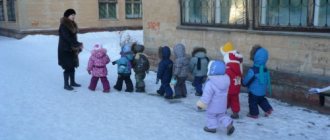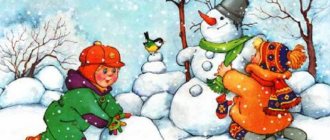Methodology for introducing preschoolers to the work of adults
Features of working in a junior preschool group
In the younger group, there are no special classes to educate the attitude towards a hard worker. This problem is solved in everyday life: observing the work of adults, in art classes, when reading works of fiction, looking at paintings and illustrations for books. Thus, when organizing observations of the work of adults, the teacher each time thinks through techniques that will help children develop a friendly attitude towards the hard worker. These techniques are varied: general conversation, involvement in an adult’s activity, memorization of a separate poem, etc.[7].
For educational purposes, the teacher uses literature in which numerous images of adults (mothers, grandmothers) evoke a feeling of sympathy. Works of fiction teach us to be attentive, caring, and friendly towards other people. For example, children are read the story “My Mother” (from the series “My Family”) by the Bulgarian writer Dora Gabe. After reading this story, the teacher asks the kids to remember what words the writer uses to talk about their mother. Children are led to the answer that “mother is kind, good, cheerful, loves her children.” Then the teacher talks about mothers in general, what they do at home, at work, who they care for and how they care.
Introducing children to the work of a janitor, driver, cook, doctor, that is, those people who work directly in kindergarten and whom children know well, you can use B. Zakhoder’s poems “Driver”, “Shoemaker”, A. Kordamova during the conversation. Our doctor" (in excerpts). Children quickly remember these verses. Thanks to them, kids learn that a doctor is a kind and brave person, he helps children if they get sick. You can also talk about the kindergarten doctor, nurse, or other doctors the children know. Gradually, the kids are, as it were, “taken” outside the kindergarten and family. They learn that there are many janitors, drivers, doctors, and teachers; they work in different places. It’s good if the janitor, driver, cook, whom the children recently met, come to the group to see how the children live. The kids will be delighted by the arrival of such guests. It will cause them a new wave of positive emotions.
Thus, it is necessary to begin labor education of children in early preschool childhood. In this case, the main means should be to introduce people who are difficult for the child to know: mothers, grandmothers, grandfathers, etc.
Features of working in the middle group of kindergarten
In the middle group, work to familiarize adults with labor and cultivate a positive attitude towards workers continues. Children of this age are independent, they have more advanced work skills compared to children, their feelings and relationships are more conscious, their interest in the life around them is broader, and their understanding of the work of kindergarten staff (music worker, teacher) is richer. All this allows us to somewhat change the nature of pedagogical work, both in content and form.
In the middle group, several new topics are being developed: “About how our mothers and fathers work,” “Who works on the farm,” “About the work of people in transport professions,” “About the work of builders.” The teacher tells the children about the content of work and its social significance. However, a story about professions becomes pedagogically significant if, when explaining the content of work, the teacher focuses not on the specification of the process, but on the person, his business and personal qualities, that is, directly or through fiction, he introduces children to a person of a certain profession. At the same time, attention is drawn to how adults conscientiously and responsibly carry out their duties, how they treat the results of work and materials with care: it speaks of the kindness, friendliness, willingness to help, and cheerfulness of a working person.
When covering each topic, the teacher thinks through two aspects: familiarization with the content of work and familiarization with the business and personal qualities of a working person[8]. For example, the topic: “About the work of builders.” Program objective: To introduce children to the work of people in construction professions: mason, painter, roofer, etc. Foster interest and respect for their work. Expanding on the topic “About the work of builders,” the teacher uses the poems of A. Brodsky “My Brother” and S. Baruzdin “Who Built This House?” It is advisable to read the last poem after the children have been on an excursion to a house under construction and have gained an idea of the work of construction workers. In this case, they perceive poetry more emotionally.
Poems by S. Baruzdin “Who built this house?” similarly analyzed in the older group. For children in the middle group, it is enough to ask the question: “Who do you think built the house in which we live?” There is no need to ensure that students list all construction professions. It is especially emphasized that the house is being built quickly thanks to the friendship of the builders, and that people are happy about their new houses.
Thus, in the middle group of kindergarten, work continues to familiarize adults with labor and cultivate a positive attitude towards the worker. At the same time, it is necessary not only to acquaint children with the content of work, but also to reveal the personal qualities of a person - a worker.
Progress of the game:
The teacher addresses the children on behalf of Masha (doll)
.
- Masha asks me for a basin, a bucket of water and soap (submits the named objects )
.
- What do you think she will do? (Wash.)
Right.
- And now Masha asks to give her a saucepan, milk, sugar, salt and millet. What is Masha going to do? (The doll wants to cook porridge.)
What is the name of the porridge?
(Millet.)
Other work activities that require appropriate items in a playful form . Children are shown these objects (an iron, a stack of doll's laundry - for ironing; a bucket and watering can - for watering the beds, etc.).
Game: “Who needs this?”
Goal: to consolidate children’s understanding of objects and their use in labor processes . Introduction to professions.
Progress of the game:
The teacher and the children stand up in a round dance and invite them to walk in a circle , saying:
Let's grow up together
We'll become astronauts
And choose a job.
And we'll launch missiles.
(Children imitate the sound of an engine and the flight of a rocket, acting as shown by the teacher).
We will become captains, (Children show how captains look through binoculars.)
We will lead the ships.
Let's become helicopter pilots (Children run and make circular movements overhead.)
We'll fly the helicopters.
Game: “Why (for what, why)
do you need to do this?
Goal: developing in children an idea of the need for work , expanding knowledge about labor processes .
Progress of the game
The teacher shows the children various objects , asks them to name them and tell them when they are used and for what purpose? For example, this is a ladle; the cook needs it to stir porridge, pour soup and compote, etc.
Game: “Choose a job”
.
Goal: the formation of elementary ideas about the professions of people whose work was not in the sphere of their observations. Arousing interest in the work of people of any profession.
Progress of the game:
The teacher tells the children: “Faith has finally recovered. We can all put things in order together. Who will take the vacuum cleaner? Take it, Galya. Who's the rag? Take it, Valya. Misha, bring us some water. Let's get started, I guess. Our faith is so neat. She loves the room to be clean and beautiful. Vera sweeps, Valya washes the floor, Galya wipes the dust. Misha, help me move the chairs. You guys do it really well. The floor is shiny, there is no dust. It comes together quickly: one or two and it’s done! Look around - cleanliness! We have a good hostess Vera. And you guys are great – you tried. Now rest, workers."
Game: "Let's go to the hospital"
.
Goal: to consolidate the idea of the medical profession ; developing children’s ability to take on the role of a doctor, perform appropriate game actions, name and use medical instruments in the game; formation of an attentive attitude towards the sick.
Material: dolls, children's doctor sets.
Progress of the game:
- Guys, listen, it seems like someone in the group is crying . Look, it was the doll Katya who was playing and injured her hand. Need to do something.
- We need to call the doctor.
- That's right, now I'll put on a white robe. I am a doctor and I will treat Katya. Here I will have a hospital, I will prepare a bandage and medicine. Let me look at your wound. Now I will anoint the wound with brilliant green and then bandage it. It won't hurt at all. Well, now, Katya, you can go home and don’t play with sharp objects . And I will see other patients.
Child - role of mother (father, doll)
.
— Hello, what hurts your daughter?
- She has a high temperature.
— Put on a thermometer and measure the temperature. Yes, the temperature is high. Let's look at the neck, open your mouth. The neck is red. Now I’ll take a phonendoscope and listen to your daughter. Your daughter has a sore throat. I will prescribe you pills, you will give one in the morning and evening, and be sure to drink hot tea with lemon.
- Goodbye.
- Next.
The child plays the role of the patient.
- Hello, patient, what hurts you?
- I have a headache.
- Take a pill and you will feel better. Go home and lie down to rest.
- Goodbye.
- Oh, the phone is ringing, I need to take the call. Hello, the doctor is listening, what happened to you? The ambulance is coming now.
“I’m leaving to see a patient; another doctor will see patients.” Lena, let's be a doctor.
The game continues with the participation of children.
Game: “We wash our combs”
.
Goal: to develop in children the skill of using and caring for their own comb. Preparing for the game. Cover the tables with oilcloth, put bowls of water for each child, soap in soap dishes, individual napkins for wiping combs, prepare a white starched robe for the bear.
Summary of a conversation in the junior group on the topic “All professions are needed, all professions are important”
Summary of the conversation in the younger group on the topic:
“All professions are needed, all professions are important”
Goals:
generalize children's knowledge about professions.
Educational objectives:
- exercise children in naming and distinguishing professions;
— improve children’s ability to understand and answer the teacher’s questions in individual words and simple sentences.
Developmental tasks:
- develop thinking, imagination, memory.
Educational tasks:
- arouse interest in the work of adults in various professions;
— stimulate endurance with the help of visual material;
— to instill in children respect for the work of adults and a careful attitude towards its results.
Equipment: pictures of professions, items characteristic of these professions.
Progress of the lesson:
Educator: Guys, today the doll Katya came to visit us and brought with her a beautiful envelope. This envelope contains interesting pictures. She really wants to show them to you. Let's look at them (shows).
-Tell me who is depicted on them. (Children answer: cook, hairdresser, policeman, doctor, teacher, builder).
- Children, how can you say in one word who this is? (professions of people). The doll Katya wants to know what other professions you know (children's answers).
-Now we will look at each picture and talk in more detail about each profession. Katya will be watching you.
Educator: Children, look at the picture and tell me who is depicted in it?
Children: Cook.
Educator: What does our cook do?
Children: Cooking soup. What kind of soup do we have? (hot)
Cooking compote. What kind of compote? (delicious, sweet)
Fries cutlets and scrambled eggs. Makes salads, bakes pies.
Educator: Pay attention to what the cook is wearing (white robe, white cap). What does he need to work? (children's answers).
Educator: Well done, guys! Now let's look at the next picture. Who is depicted on it?
Children: Hairdresser.
Educator: Well done! What does our hairdresser do?
Children: cuts hair, dyes hair, does beautiful hairstyles.
Educator: The hairdresser also has special clothes for work. This is an apron. Okay guys. Next picture. Who is depicted on it?
Children: Policeman.
Educator: What does a policeman do here?
Children: Responsible for safety, keeping order. Let's look at his clothes and items needed for work.
Educator: Well done! You are very attentive.
Educator: Let's look at the next picture. Who is depicted on it?
Children: Doctor.
Educator: Correct. What does our doctor do?
Children: Treats patients, measures temperature, gives an injection, listens to the heart, prescribes medicine.
Educator: That's right, children. Tell me the items characteristic of a doctor’s work (children’s answers). Let's look at the next picture and say who is depicted in it?
Children: Builder.
Educator: What does a builder do?
Children: Builds a house, school, kindergarten, garage, fence, gate, erects a bridge.
Educator: Great, you are saying everything correctly. The builder has his own special clothes. What will he need for work? Let's choose these items (choose with the teacher). Next picture. Who is depicted on it?
Children: Teacher.
Educator: What does our teacher do?
Children: Teaches children, assigns homework. Find the items needed in a teacher's job.
Educator: That's right. Well done, you are so smart.
Final part:
— Children, what professions do you remember?
— What profession did you like?
—What do you want to become when you grow up?
- Children, you were all great today! They were very smart, active, and took our conversation responsibly.
Offer children a game with clothespins “Who needs what for work”





